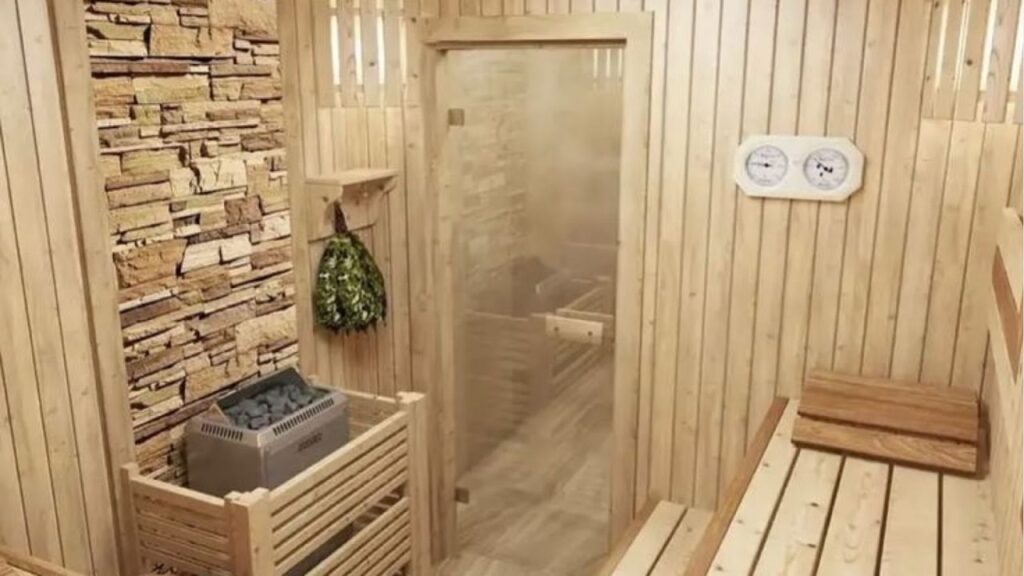Seeking ways to incorporate elegance into your living space? Contrary to what you might imagine, building your private sauna is easier than you think! So, in this guide, you’ll learn about saunas for home, including which materials are best to use and how to install them.
Source: Pinterest
Want a full-on spa experience, we’ve got you covered with details to help you get started.
Consider Location and Size When Installing a Sauna
Location is essential when installing saunas for home use. So, look for a well-ventilated spot that can handle moisture. It can be a corner in your bathroom or even a basement if you don’t mind that.
Source: Pinterest
Think of the size – a typical household sauna can be small or spacious, depending on the number of people you wish to accommodate.
Use Dry Saunas For Your DIY Project
Dry saunas for home are easier to install for a beginner DIYer. They’re less complex than steam saunas because you don’t require any extra plumbing work.
Source: Pinterest
Dry heat is ideal for relaxation and you can easily set up an at home sauna if you have the appropriate resources. Plus, they’re great for those who wish to have low-maintenance home saunas.
Tools You Need for DIY Saunas for Home
When constructing your saunas for home, some of the tools that you’ll need are; a saw, screwdriver, drill, and measuring tape. It’s also necessary to have insulation materials and cedar wood panels for the walls of your sauna. Don’t forget your safety gear!
Source: Pinterest
Getting the right tools and materials will make building your household sauna so much easier and quicker.
Installing Proper Insulation Makes All the Difference
Insulation is necessary for retaining heat in saunas for home. Most DIYers use fiberglass insulation for walls and ceilings to ensure that heat is retained. Proper insulation allows your household sauna to heat up faster and stay warm longer, making it energy-efficient.
Source: Pinterest
It also assists in preventing the buildup of moisture – making it a useful feature in any home sauna design.
Set Up Your Frame and Walls
Build the frame of your home sauna by measuring the wood and cutting for the structure.
Source: Pinterest
The interior walls should be covered with cedar or hemlock since these woods are resistant to heat and they’re very strong. Make sure the walls are sealed tightly for optimal heat retention in your at home sauna.
Ventilation is Key for a Safe Sauna
Proper ventilation is also important in ensuring that your household sauna is safe and comfortable to use. So, you’ll require intake and outtake vents to control the flow of air.

This avoids overheating and enables fresh air into your sauna for home.
Source: Pinterest
Ventilation also plays a vital role in avoiding mold and mildew, particularly in moist areas, to ensure your at home sauna lasts.
Which is the Best Heater Type For Household Sauna?
The heart of any sauna for home is the heater. Electric heaters are the most common for saunas for your home because they’re easy to install and safe.
Source: Pinterest
But, if you’re more experienced, you could go with a wood-burning stove, but they require more maintenance. So, always choose a heater that fits your at home sauna space and power needs.
Plan Electrical Setup Early
When it comes to the installation of an electric heater for your sauna at home, the electrical setup is very important. So, ensure that any wiring required is done by a professional so that there are no electrical hazards.
Source: Pinterest
The average household sauna heater needs 220 volts, so consult with an electrician to determine if your home’s electrical system can handle the load.
Choose the Right Wood for Your Home Sauna
When choosing the wood for home saunas, the most common types are cedar and hemlock. But, cedar is resistant to warping and has a good smell, making it ideal for saunas for home use.
Source: Pinterest
On the other hand, hemlock is cheaper while still being durable. In any case, ensure that the wood you select is heat resistant and safe for saunas for your home.
Install Benches and Comfort Features
Now it’s time to make your sauna for home a bit comfy! So, begin by placing benches made from heat-resistant wood such as cedar.
Source: Pinterest
You can also include options such as height-adjustable seats, dim lighting, or music to set the mood. Such details can help you create a luxurious atmosphere in your at home sauna.
Keep Maintenance Simple
Maintaining your household sauna isn’t difficult if the sauna is clean and properly ventilated. So, wipe down surfaces after each use to prevent sweat and dirt buildup.
Source: Pinterest
If you’re using a dry sauna for home, it’s important to clean the floor, especially if there’s debris that accumulates over time. Regular maintenance keeps your at home sauna in great condition for years to come.
